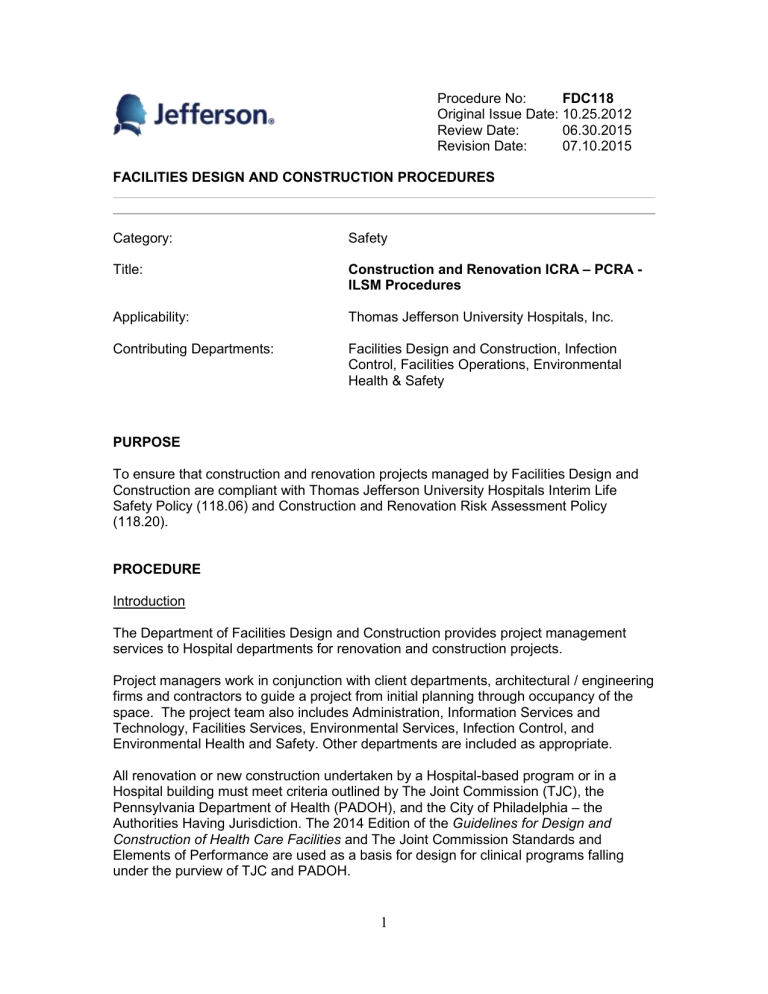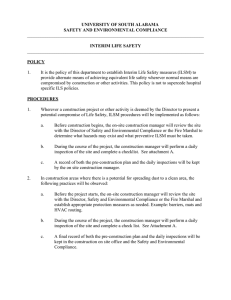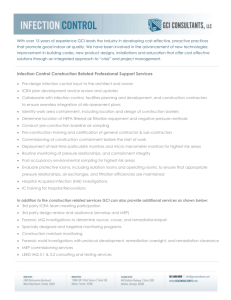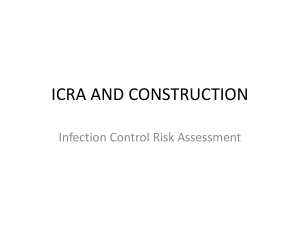Procedure No: Original Issue Date: 10.25.2012 Review Date: 06.30.2015

Procedure No: FDC118
Original Issue Date: 10.25.2012
Review Date:
Revision Date:
06.30.2015
07.10.2015
FACILITIES DESIGN AND CONSTRUCTION PROCEDURES
Category:
Title:
Applicability:
Contributing Departments:
Safety
Construction and Renovation ICRA – PCRA -
ILSM Procedures
Thomas Jefferson University Hospitals, Inc.
Facilities Design and Construction, Infection
Control, Facilities Operations, Environmental
Health & Safety
PURPOSE
To ensure that construction and renovation projects managed by Facilities Design and
Construction are compliant with Thomas Jefferson University Hospitals Interim Life
Safety Policy (118.06) and Construction and Renovation Risk Assessment Policy
(118.20).
PROCEDURE
Introduction
The Department of Facilities Design and Construction provides project management services to Hospital departments for renovation and construction projects.
Project managers work in conjunction with client departments, architectural / engineering firms and contractors to guide a project from initial planning through occupancy of the space. The project team also includes Administration, Information Services and
Technology, Facilities Services, Environmental Services, Infection Control, and
Environmental Health and Safety. Other departments are included as appropriate.
All renovation or new construction undertaken by a Hospital-based program or in a
Hospital building must meet criteria outlined by The Joint Commission (TJC), the
Pennsylvania Department of Health (PADOH), and the City of Philadelphia – the
Authorities Having Jurisdiction. The 2014 Edition of the Guidelines for Design and
Construction of Health Care Facilities and The Joint Commission Standards and
Elements of Performance are used as a basis for design for clinical programs falling under the purview of TJC and PADOH.
1
Construction and Renovation ICRA – PCRA – ILSM Procedures 07/10/2015
Responsibility for ensuring that design and construction projects meet the aforementioned requirements lies with the project manager, design professionals, contractor, infection control practitioner, safety officer and administrators. The project manager will take the lead in including the appropriate stakeholders throughout the process.
Forms and Uses
Thomas Jefferson University Hospitals has an ICRA / PCRA / ILSM Multidisciplinary
Committee that meets bi-weekly to review upcoming construction projects. The
Committee is responsible for signing off on Infection Control Project Design Reviews and completing Infection Control Risk Assessments (ICRA), Pre-Construction Risk
Assessments (PCRA) and Interim Life Safety Measures (ILSM) for those projects.
The Committee process utilizes the following forms:
1. Infection Control Project Design Review. This form is completed during the design phase by the design team, project manager, client department and infection control to ensure that program elements required by the Guidelines are included in the plan.
Examples include determination of the number of protective environment patient rooms, number and location of hand washing sinks, and appropriate finishes for project areas.
An infection control practitioner and the project manager sign off on the form. The completed form is reviewed with the Multidisciplinary Committee. The original form is maintained as part of the Committee file.
Note that for small scale or uncomplicated projects, this form may be completed during a Committee meeting.
2. ICRA - The Infection Control Risk Assessment and Permit form serves two functions: a) determines the Infection Control Risk Level, and b) serves as a
“permit” for construction.
For projects with multiple design phases or that require review by PADOH, the form is completed during design. The project manager completes the top portion of the form; the infection control practitioner identifies the Construction Activity and Infection Control Risk Group; and assigns an ICRA class. The original form is maintained as part of the Committee file.
Prior to construction, the project manager convenes a pre-construction meeting that includes the design team, contractor, director of renovation and construction, infection control practitioner, and safety officer. The project manager brings the original ICRA form to the meeting. The ICRA level and precautions are reviewed with the contractor, who signs off on the form. A copy of the form is maintained on the construction site; the original is returned to the Committee file.
2
Construction and Renovation ICRA – PCRA – ILSM Procedures 07/10/2015
3. PCRA - The Pre-Construction Risk Assessment form is completed during the construction documentation phase. The project manager completes the top portion of the forms and checks the appropriate boxes and elaborates on items as needed. The form is reviewed by the Multidisciplinary Committee and signed off by the Chairperson of the Committee or his / her designee. The original form is maintained as part of the Committee file.
4. ILSM - The Interim Life Safety Measures (ILSM) Assessment Form is completed during the construction documentation phase. It identifies deficiencies in building systems or safety risks that will be present during the construction period. The project manager completes the top section of the form and completes the preassessment by indicating (yes or no) whether conditions of a deficiency or impairment exist. The Fire Marshal or Safety Officer then confirms whether the deficiencies or impairments are significant, and if so, checks the appropriate measures. If, in the professional opinion of the Fire Marshal or Safety Officer, any identified deficiencies or impairments are deemed to be significant, ILSM’s will be identified by checking the appropriate cell(s) on the grid in the assessment portion of the ILSM Assessment Form.
The ILSM Assessment Form indicates criteria for evaluating when and to what extent measures are typically required to compensate for increased life safety risk due to impairment during construction or renovation activities. Recognizing that it is impossible to identify all unique conditions within which a deficiency or impairment may occur, mitigating conditions may allow the professional discretion of the Fire Marshal or Safety Director to reasonably and safely not select or implement some typical measures which may be deemed unnecessary on a case by case basis. Mitigating conditions may include, but are not limited to: Trained staff in the area; Small size of the deficiency; Area with lower impact to patient population; Short duration of the deficiency; and other means of fire suppression, or fire alarm, or exit in the area. The original form is maintained as part of the committee file.
In accordance with Philadelphia Fire Department (PFD) requirements, any impairment of any fire protection system (suppression, detection, or notification) effecting any area greater than 30,000 square feet of any one floor or one full floor, or multiple floors, will be reported to the PFD by the Fire Marshal or designee as a fire system impairment regardless of the duration of the impairment.
Prior to construction, the project manager convenes a pre-construction meeting that includes the design team, contractor, director of renovation and construction, infection control practitioner, and Fire Marshal or Safety Officer. The project manager brings the original ILSM form to the meeting. The ILSMs are reviewed with the contractor, who signs off on the form. A copy of the form is maintained on the construction site; the original is returned to the Committee file.
Circumstances and conditions on job sites will change as different phases are undertaken and/or as work progresses. Project requirements will be re-evaluated, and the infection control practitioner and Fire Marshal or Safety Officer will modify the ICRA and ILSM as appropriate. Changes will be maintained as part of the Committee file.
3
Construction and Renovation ICRA – PCRA – ILSM Procedures 07/10/2015
When planning projects, project managers must take into account construction activities that will take place outside of the main job site. It is necessary that ICRA and ILSMs are completed for areas adjacent to, above, below or remote from the site. A separate set of forms will be required, as the ICRA level and safety measures may be different from the main job site.
Compliance
The Project Manager is responsible for notifying Infection Control and Environmental
Health and Safety prior to the start of work, when activity levels or circumstances change, and when work has been completed.
Any significant breach in the ICRA enclosure or other non-compliant condition must be reported to Infection Control and the project manager immediately. Corrective action must be taken and the area re-inspected.
Any significant deficiencies in the ILSM must be reported to Environmental Health and
Safety and the project manager immediately. Corrective action must be taken and the area re-inspected.
The contractor is responsible for maintaining the construction site according to the ICRA and ILSM. The contractor will maintain a log with Daily Construction Checklist form, which is completed twice per shift worked and signed off by the superintendent. The log, along with the ICRA permit, ILSM form and a HEPA log must be available on site at all times.
As part of the monitoring process, the project manager will complete a Construction Site
Observation Report. Deficiencies are noted; appropriate departments notified; corrective action is taken. If deficiencies or corrective action are noted, the site observer reviews the form with and obtains signoff from the contractor’s superintendent. The original form is maintained in the Committee file.
Project Flow for Renovation or New Construction
Renovation or new construction projects can have distinct phases of design services.
Once a project area and program have been defined, the project proceeds through schematic design, design development, construction documentation, and construction administration. On smaller, less complex projects, the design services may be combined into fewer distinct phases. The project team will address infection control and risk assessment throughout design to ensure that all Guideline requirements are satisfied. This applies to the main construction area and any adjacent or remote areas directly affected by the project.
Because projects vary in size and complexity, not every project will require distinct design phases. The project manager should use his or her best judgment to ensure that the documentation described below has been completed and presented to the
Multidisciplinary Committee.
4
Construction and Renovation ICRA – PCRA – ILSM Procedures 07/10/2015
1. Schematic Design
The purpose of this project phase is to determine that all program elements fit within the space allotted and all general elements of design are included. For projects involving patient care, all PADOH requirements are identified and included in the plan. Infection
Control should be included in one meeting during the process. The Infection Control
Project Design Review form is completed during this phase.
2. Design Development
The purpose of this project phase is to confirm the plan and begin to provide detail for each space. The MEP and structural elements of the plan begin to take shape during design development. Note that schematic design may be folded into design development. If so, then the Infection Control Project Design Review form should be completed during design development.
ICRA permits and PCRA forms should be completed during design development for large or complex projects to ensure that all infection control and construction risks can be assessed and addressed during construction documentation.
3. Construction Documentation
The purpose of this project phase is to develop a complete set of drawings ready for construction bids. This includes all aspects of the program from an architectural and engineering perspective. If required, construction documents are reviewed and approved by the PADOH. The first portion of the ICRA Permit must be completed and included in the construction documents for DOH review.
The project manager will prepare a package for review by the Committee during construction documentation. This package will include: a. A drawing of the project area b. Infection Control Project Design Review form (may have been reviewed earlier in the project) c. Infection Control Risk Assessment and Permit d. Pre-Construction Risk Assessment form e. Interim Life Safety Measures (ILSM) Assessment Form
Separate ICRA and ILSM forms are required for space adjacent to or remote from the construction area. This ensures that the appropriate precautions are taken, particularly since those precautions likely differ from the main project area.
4. Construction Administration
The purpose of this project phase is to prepare for, commence and complete renovation or construction in the project area. Requirements apply not only to the construction area, but to spaces adjacent to or remote from the main project area.
5
Construction and Renovation ICRA – PCRA – ILSM Procedures 07/10/2015
Prior to the start of renovations or construction, the project manager convenes a preconstruction meeting that includes Infection Control and Environmental Health and
Safety. During this meeting: a. The infection control practitioner reviews the ICRA requirements with the contractor, who signs the form. b. The Fire Marshal or Safety Officer reviews the ILSMs with the contractor, who signs the form. c. The contractor’s daily check-list is reviewed with the contractor, noting that the log must be maintained on site at all times. d. Required signs are provided.
The Fire Marshal or Safety Officer is responsible for implementing the following ILSM’s as deemed required:
Notifying the Philadelphia Fire Department (and Insurance Company)
Implementing a fire watch for fire detection, fire alarm, and fire suppression system impairments (Hot Work fire watches are the responsibility of maintenance and contractors)
Providing additional training to staff on the use of firefighting equipment
Conducting additional fire drills
Conducting education to promote awareness of building deficiencies, construction hazards, and temporary measures implemented to maintain fire safety
Training staff to compensate for impaired structural or compartmental fire safety features
The project manager (through contractor as directed) is responsible for implementing the following measures as deemed required:
Posting signs identifying the location of alternative exits
Inspecting exits in affected areas on a daily basis
Installing temporary fire alarm and detection systems
Providing additional firefighting equipment
Installing temporary construction partitions that are smoke-tight, or made of noncombustible material or limited-combustible material
Providing increased surveillance of buildings, grounds, and equipment, giving special attention to construction areas and storage, excavation, and field offices
Enforcing storage, housekeeping and debris-removal practices that reduce the building’s flammable and combustible fire load to the lowest feasible level
Inspecting and testing temporary systems monthly and documenting dates
(coordinated with Facilities Operations fire technicians)
6
Construction and Renovation ICRA – PCRA – ILSM Procedures 07/10/2015
The project manager, infection control practitioner, Fire Marshal, and Safety Officer (or designee) will visit the site independently throughout construction. The type and intensity of construction activities will dictate the frequency of visits. Different time frames may be necessary or advisable based on specific circumstances. The following guidelines are used for construction site visits: a. The project manager will inspect on a weekly basis during active construction b. The Fire Marshal or Safety Officer (or designee) will inspect construction sites when an ILSM for a significant impairment is in effect c. The infection control practitioner will inspect Level II ICRA areas at the start and completion of work and Level III and IV ICRA areas on a weekly basis
Upon completion of the work, and if the scope dictates, Infection Control and the project manager inspect site to ensure that all work is complete and the area is appropriately cleaned. If applicable, Environmental Health and Safety inspects the site to ensure that new or different fire safety elements (i.e., evacuation maps, fire extinguishers, exit signs) are in place.
Monitoring
Implementation of ILSM’s will be monitored by the Fire Marshal or Safety Officer.
Contractors are responsible for providin g copies of the Contractor’s Daily Check List to the office of Facilities Design and construction monthly.
Project Managers will file Site Observation Reports in the ICRA / PCRA / ILSM
Committee files. Reports should include any correspondence or documentation related to a deficiency and the corrective action with the report.
On a quarterly basis, Facilities Design and Construction will prepare a report for review at an ICRA / PCRA / ILSM Committee meeting. Data submitted will include:
1. Summary of project activity for the past quarter: a. Number of projects presented to the committee b. Number of projects in design, construction or having completed construction
2. Audit of Site Observation reports: a. % of reports without deficiencies noted b. % of reports with deficiencies noted i. By category (ICRA or ILSM) ii. By contractor iii. By deficiency type
3. Audit of Contractors Daily Checklist: a. Submitted each month for each active construction project. b. % of compliance i. All items checked twice per shift
7
Construction and Renovation ICRA – PCRA – ILSM Procedures 07/10/2015 ii. Form signed by superintendent iii. ICRA barriers intact and entrance secured iv. Negative pressure checked and reading noted
Reports are reviewed by the ICRA / PCRA / ILSM committee quarterly and maintained in the office of Facilities Design and Construction.
Quarterly performance reports will be submitted to the Environment of Care Safety
Subcommittee for further review.
Record Keeping
Committee materials, monitoring forms and quarterly performance reports are maintained in the office of Facilities Design and Construction. A duplicate set of sitespecific forms will be maintained at the Methodist Campus. Documentation includes:
1. Original forms are maintained in a binder by FDC number. a. Infection Control Project Design Review b. Infection Control Risk Assessment and Permit c. Pre-Construction Risk Assessment d. Interim Life Safety Measures
2. The Facilities Design and Construction PCRA / ICRA / ILSM Summary Report is maintained with the forms. Information tracked includes: a. Project Name, FDC#, Project Manager, Location b. Review dates and approval status c. ICRA precaution class d. Project phase, start and completion dates
3. Meeting materials are kept in a separate binder, filed by meeting date, and include: a. Agenda b. Meeting Minutes c. Blank copies of distributed materials d. Sign-in sheet
4. Monitoring forms are maintained in a separate binder filed by quarter by project.
5. Quarterly performance reports are maintained in a separate binder filed by quarter.
6. Electronic copies of materials are maintained in a Facilities share drive and in the
Department of Facilities Design and Construction project management system.
8
Construction and Renovation ICRA – PCRA – ILSM Procedures 07/10/2015
Attachments:
A. Infection Control Project Design Review Form
B. Infection Control Risk Assessment and Permit Form
C. Pre-Construction Risk Assessment (PCRA) Form
D. ILSM Assessment Form
E. Daily Construction Check List Form
F. Construction Site Observation Report Form
Original Issue Date: 10/25/2012
Revision Dates: 11/15/2013, 01/05/2015, 07/10/2015
Responsibility for Maintenance of Policy: Director, Facilities Design and Construction
Approved by:
Frank Daly
Assoc. Vice President, Facilities
9





